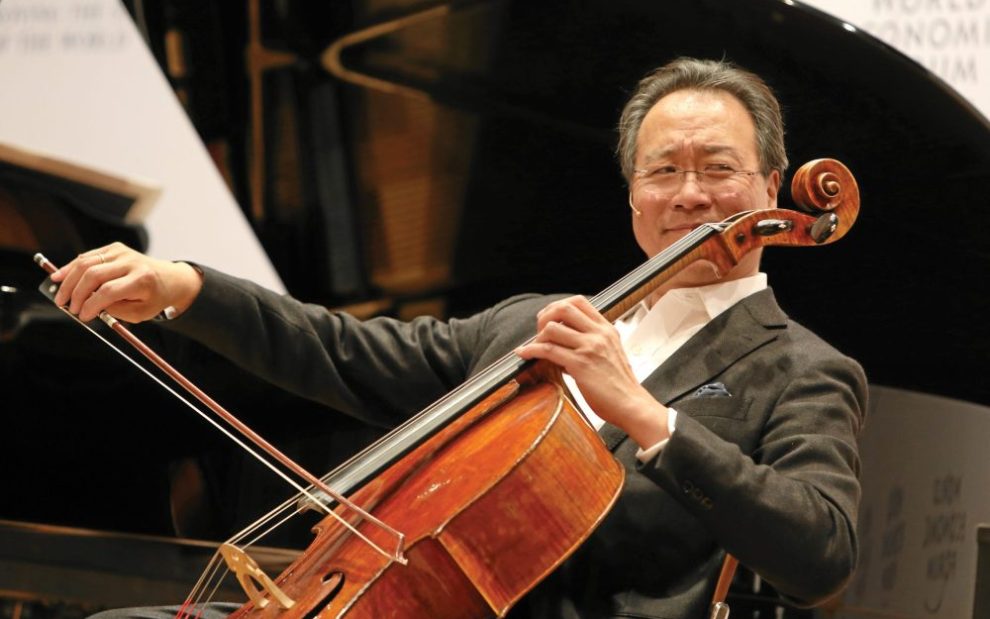Among my favorite episodes of the award-winning NBC series from the 1990s, The West Wing, is one titled “Nöel,” which features a guest appearance by cellist Yo-Yo Ma. In its climactic scene, set at a congressional Christmas party, Ma, playing himself, performs Johann Sebastian Bach’s Cello Suite No. 1 in G Major.
Rather than fake his way through the scene’s taping with the help of overdubbing, the musician reportedly executed the piece live for multiple takes, never straying from his initial rhythm or intonation. Equally remarkable to those who witnessed the feat was the carefreeness with which Ma treated the 18th-century Italian instrument he carried onto the set. Since the show’s conclusion in 2006, its cast and crew have recounted numerous times how the visiting Ma handed over his beloved “Petunia” to complete strangers, though the one-of-a-kind object is said to be worth more than $2 million.
“The experience was extraordinary for all of us,” the scene’s director, Tommy Schlamme, told Entertainment Weekly during a Zoom-style group interview in 2020. “[Ma] showed up at 6:30 in the morning, before call, with a cello on his back, which he allowed everyone to play.” Schlamme went on to praise the “duet” Ma struck up between takes with cast member Dulé Hill, an accomplished tap dancer. Richard Schiff, who played White House communications director Toby Ziegler on the show, remembers the cellist being “ecstatic” about collaborating with Hill, a reflection not only of his musical wits but also of the generosity that’s marked his career from the beginning.
Fellow cast member Bradley Whitford, who played White House deputy chief of staff Josh Lyman, concurs. “[Ma’s] all about breaking down the lines of hierarchy and pretension in his classical music world,” he told the New York Times recently. “[On the day of his visit to The West Wing], he came out into a room full of probably a hundred background artists, with his extraordinary cello, and he said: ‘Does anyone want to play this? Does anyone want to hold it?’ ”
The West Wing team isn’t alone in recognizing the unique combination of virtuosity and humility Ma brings to each of his performances. He’s been called “America’s greatest living ambassador for classical music” and celebrated widely for the respect he shows his listeners—or “guests,” as he calls them—whether they’re fans of classical music or not. “Proving something” to audiences isn’t his aim, he insists. Rather, he invites them to share in an experience intended to be “really special for all of us.”
Lately, amid the church’s interminable culture wars and what seems an increased push on the part of some clergy to reassert control over a liturgy that, in their minds, has been forfeited to laypeople as a consequence of the Second Vatican Council, I’ve found myself wondering what we might learn from Ma about the art of public ministry. These days, it’s the rare priest or bishop who seems genuinely interested in expanding the place of laypeople in liturgical life as opposed to shrinking it.
Among those in pastoral positions openly dismissive of the council’s instructions and stuck even on the propriety of so commonplace a practice as, say, “communion in the hand,” one finds it difficult to imagine a priest willing to conclude the Fraction rite of the Mass with a variation on Ma’s invitation to his West Wing collaborators. “Behold the lamb of God,” he could declare as usual, straight from the Missal. “Now, would anyone else like to hold for themselves this precious gift of his body and blood?”
Yet, it’s precisely the generosity with which Ma shares his own gifts with others that the church might wish to emulate. Whatever else might be said of the man, after all, Ma is the consummate entertainer—a fitting title drawn from the Old French entretenire, meaning to coax others into the sphere of one’s influence through an outpouring of generosity. Like other members of the country’s so-called “creative class,” those painters, dancers, actors, and others who, in one way or another, beguile audiences through their spirit of largesse, Ma wins over listeners of all kinds by treating them as equals—at least as concerns their humanity.
The cellist isn’t known to compromise on the quality of the music he performs, whether it be for young fans of Sesame Street or the most discerning of concertgoers. Nor is he opposed to stretching the listening habits of his most loyal fans by bringing to life the works of contemporary composers penned with his talents in mind. Yet, Ma never succumbs to pedantry, so eager is he to serve the music placed before him to its intended recipients. His is an art of mediation. He brokers the relationship between composer and audience in a way that wins him attention and anonymity at the same time. This is most obvious in formal settings, perhaps, where, dressed in tie and tails or some other version of “concert black,” his compact figure recedes into the frieze of black-and-whiteness formed by his fellow musicians.
Conscious of our own status as mediators of God’s grace to a world in need of redeeming, we Catholics shouldn’t shrink from imitating Ma, whose methods for rendering even the most arcane aspects of music accessible to the masses may have greatest application in the area of corporate worship. Here, in fact, are a handful of lessons the church might draw from Ma that, in my mind at least, are as useful as anything to be found in a dusty liturgical manual.
Sullenness is no requirement of solemnity
Contrary to the opinions of some, no celebration of the Mass is improved by its participants appearing glum, sullen, or out to lunch. It’s OK to close our eyes, smile, and assume the appearance of people actually consumed by joy—as Ma routinely does on stage—confident, in our case, that it’s God who ultimately draws the greatest pleasure from those acts of worship in which we are deeply immersed.
In response to the applause that meets the conclusion of even his solemnest performances, Ma almost always breaks into a toothy grin that elicits the same from those in his presence. The impulse toward rapture builds throughout a performance for the player and listeners alike, an experience that might rightly characterize the Mass as well, an event celebrated by a church “happy to be called to the Supper of the Lord.”
Performance is its own kind of catechesis
Even those admirers of Ma who are newcomers to classical music find themselves prompted to accept its relevance in response to the cellist’s own behaviors. In a sense, popular respect for the man’s artistry translates into respect for the man himself—even apart from his cello. This, in turn, fosters increased attentiveness to the music. Like all great teachers, Ma educes from his audiences the most discerning qualities of their ears and minds and makes real listeners of them.
Likewise, by doing liturgy with conviction, beauty, and deliberateness, a presiding priest wins over his congregation to the admittedly demanding art of praying the Mass. A body of lay worshippers is more likely to participate in rituals that are performed well as opposed to ones that are not. Their members, in turn, teach each other to pray as they should by imitating each other.
Silence is as expressive a thing as sound
To listen to Ma perform is to confront validation of the truism attributed to French composer Claude Debussy that music consists as much in the “silence between the notes” as it does in the sounds of the notes themselves. In Ma’s hands, silence isn’t the absence of music, any more than the open cavities or “negative spaces” to be found in the works of any sculptor or architect represent an absence of art. Silence is as essential an ingredient to music as sound. Some composers and players may argue it’s even more important.
This is likewise the case with liturgy, of course, though one would hardly get this impression today from the way in which the average U.S. Catholic parish worships. The noise that pervades the world beyond our churches now infiltrates them at a level one couldn’t have imagined only a few decades ago. To experience the true beauty of worship, however, we must be willing to enter into those moments of silence “between the notes” when God does most of the talking.
In the end, what Ma offers us are keys to enacting the sort of “new evangelization” he began to practice long before this behavior became fashionable with the church. Like such popularizers of classical music as Leonard Bernstein, André Previn, opera soprano Beverly Sills, or even fellow cellist Pablo Casals, Ma has sought to transform an artform previously enjoyed by “the few” into one accessible to the many. He’s also helped chip away at the Eurocentrism and dependence on the canon of Classical and Romantic compositions from which concert programs in this country have for so long been constructed. In his hands, the works of living composers, by both women and men, are shown to be as worthy of adulation as any.
To be sure, Ma has had his detractors, purists mostly, who are convinced that to democratize high art is ultimately to debase it. A similar argument, seemingly buttressed by Jesus’ own injunction against squandering the loveliness of worship on “dogs and swine” (Matt. 7:6), is made by those within the church still resistant to Mass in the vernacular, music fitted to the singing abilities of the average congregation, or sanctuaries filled with laypeople involved in a range of ministries.
It wasn’t the stupidity or even the irreligiousness of its adversaries from which Jesus hoped to preserve the message of the early church, however, but rather their hostility toward it. We really can’t find an instance in scripture where Jesus withholds the Good News from anyone for lack of a theology degree or some sufficiently churchy demeanor. So it is with Ma, who casts his seeds of music appreciation with gleeful abandon, leaving them free to fall where they may and, sometimes, take root in good soil.
This article also appears in the December 2022 issue of U.S. Catholic (Vol. 87, No. 12, pages 15-17). Click here to subscribe to the magazine.














Add comment